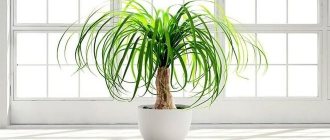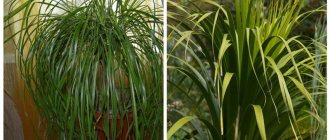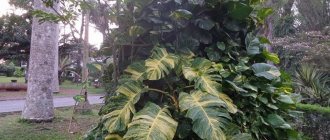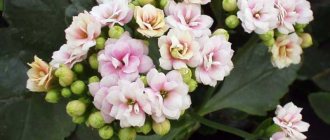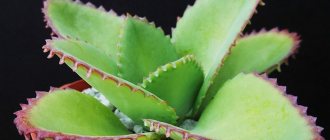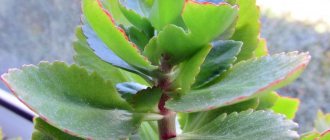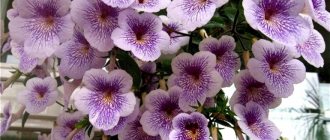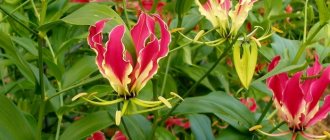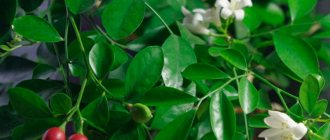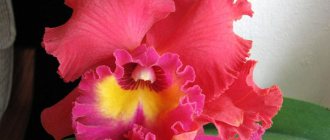The elephant foot flower is a very interesting and unpretentious house plant. It is also called horsetail, nolina, bocarney, bottle palm. It came to us from the southern arid countries, so it is accustomed to storing moisture for a long time. This moisture accumulates at the base of the trunk, and in this part it becomes thicker. At the top of the flower there are thin leaves resembling a palm tree. This unusual appearance is what made the elephant foot indoor flower popular.
The photo will remind you of a plant that many people have seen, but did not know what it was called.
Light
These plants will grow slowly and although will do well in a slightly shaded location, they need bright light to thrive. If you provide some sun, within a few weeks you will see the plant turn this into lush new leaves, meaning more light means more growth.
Nolina plants grown in the shade should not be suddenly moved and thrown into a very sunny location. Move the plant to this new location for a few hours a day and then back again. Do this for a week to get used to the change in light intensity. This will prevent the leaves from becoming disfigured.
Caring for bokarneya at home. Details
Home bokarnia is an unpretentious plant, but in order for its unique beauty to be fully revealed, you need to create optimal conditions.
Flowering nolina, bocarnea
Under natural conditions, only mature bocarnea blooms, forming many tiny light lilac flowers collected in panicles. Beautiful long inflorescences descend from the top of the tree, spreading a delicate aroma around.
Flowering of nolina and bocarnea at home is impossible. The plant only occasionally forms a peduncle, which is pinched to form a beautiful crown.
Temperature
To make the tree look attractive, it is necessary to maintain a certain temperature regime. In winter, the nolina plant should be kept at + 7 – 13°C. In summer, it is advisable that the thermometer does not rise above + 20°C.
Spraying
Bocarnea prefers average air humidity, so spraying is carried out only in hot weather with dry soil. They do this carefully, trying not to touch the trunk. Sometimes the foliage is wiped with a clean soft cloth.
Lighting
The tropical bocarney plant feels great at home in the southeastern and southern zones of the house. It is here that it will receive the bright lighting necessary for development. In less bright places, nolina will slow down, or even stop, its growth.
It is recommended to turn the tree with different sides to the sun to form a beautiful crown. When warm weather sets in in the spring, the plant is taken out into the fresh air. Place away from prevailing winds and drafts. The duration of daylight for normal development of bocarnea should be at least 10 hours. In winter, phytolamps are turned on.
Watering bocarneya
Excess moisture can destroy nolina. Enough time should pass between waterings so that the surface of the substrate has time to dry. Bokarneya is watered infrequently, but quite abundantly: in the summer - every 5 days, in the autumn and spring - after 12 days.
In winter, watering is stopped. The colder it is outside, the less often you should water. A clear sign of the need for watering is the shrinking and softening of the trunk. Use settled lukewarm water.
Nolina pot
The root system of the plant is located superficially, so nolina grows favorably at home and feels good in a low, wide container. Each new pot for nolina should be 2.5 cm larger than the previous one and stand steadily on a flat surface.
When determining the height of the pot, you need to understand that 1/3 of it is filled with drainage. There should be holes made at the bottom of the container for drainage. Mature plants are planted in tubs.
Soil for bocarnaia
Caring for bocarney at home requires planting the plant in a loose, breathable substrate. You can prepare your own soil for bocarnea from two parts of leaf soil and clay and one part of sand and brick chips. You can buy a soil mixture for succulents in the store and supplement it with charcoal powder and chopped sphagnum.
Feeding and fertilizer
When watering the bocarnea, combine feeding and fertilizing with a solution for succulents, diluted by half. The plant is fed only in summer, once every 14 days. After feeding, the plant is kept in the shade for 2 days.
Transfer
Young bushes are replanted once every 2.5 - 3 years, adults - once every 4.5 years, when they need a pot of a larger diameter. Mature plants that are more than 15 years old should be replanted only in extreme cases: when the root or trunk rots.
In other cases, they only refresh the top layer of soil. Bocarnea transplantation is carried out in the spring
This is done very carefully so as not to damage the roots and not to deepen the growing point. After transplantation, nolina can be watered after 4 days, and fed after 2.5 weeks.
How to prune bocarneya?
Plants are pruned to remove damaged parts or to give the crown a neat appearance. Nolina pruning is carried out irregularly, according to the decision of the grower. Each new “haircut” allows the tree to look neat and stylish.
Rest period
Bocarnea can grow tirelessly throughout the year, but rest is necessary for every living creature to prolong its existence and improve its health. A caring owner will artificially create a dormant period for the plant in winter, lowering the temperature to + 13°C, limiting watering and refusing stimulating fertilizing.
Watering
At the base of Nolina there is a thick, swollen stem that has a woody appearance. It is a water storage organ that can support the plant during drought. This characteristic feature in the flower description should indicate to you that the plant is ready for long periods between waterings. An excellent houseplant for those who enjoy peace of mind and low maintenance.
Tip: If you grow your flower in a very small pot with little soil, it will dry out faster and may need more frequent watering, this is an important detail in how to water your flower.
Ideally, you should aim to water at least a few times a month (once a week in high summer if possible), and make sure it's a thorough watering.
Water supplies will support the plant if you forget to water it from time to time, but don't make it a habit or you'll end up with a struggling plant rather than a thriving one.
Description
Elephant foot is a perennial tropical plant of the butcher family. It grows wild in southern Mexico and is sometimes found in the southern United States.
The elephant leg looks like a short tree with an inflated base of the trunk. This feature allows plants to survive drought. After flowering, lush, branched greenery appears at the elephant's foot. This effect can be achieved faster with a haircut. Of course, an adult, formed plant is very expensive, so young specimens are more often found on sale. They are cheaper, but to form a typical elephant leg, you will have to spend a lot of time (more than one season). The indoor elephant foot flower blooms extremely rarely.
The plant has a very interesting root system - the roots grow not in depth, but in breadth. Therefore, elephant legs are grown in wide containers with good drainage. To prevent a crust from forming on the soil, the top can be covered with fine gravel. This will also serve as an additional decoration.
Temperature
When it comes to temperature requirements, unlike most houseplants, Nolina is almost hardy and can withstand sub-zero temperatures. However, when growing at home, your plant's exposure to such low temperatures will likely be an accident rather than a common occurrence, right?
To be on the safe side, try not to go below 7°C, and although higher temperatures are acceptable, you should achieve good growth at around 21°C.
Diseases and pests of nolina
Indoor nolins are not too susceptible to diseases and pests do not often settle on them. For Nolina (Bocarnea) reflexum, proper care is the basis for obtaining a healthy plant, and the basis for care for Nolina is watering. With excessive watering, bocarney, having its own reserves of moisture in the caudex and leaves adapted to semi-desert conditions, is not able to absorb excess moisture. Its leaves begin to become covered with brown spots, the shoots become soft, and the roots rot.
Excessive watering is especially dangerous at low temperatures and lack of lighting. You can try to save such a plant. Cut off all rotten parts, treat them with activated carbon and replant the nolina in new, dry soil. After transplanting, do not water for at least a week, then water moderately.
If the leaves of nolina dry out, the reason may be that the air is too dry or the temperature is too high. In this case, you can spray the plant, but the moisture should only fall on the leaves and not on the trunk. Otherwise, brown spots will form on the trunk and it may rot. The leaves dry out both from too infrequent watering and from a lack of nutrient reserves in the soil. Old lower leaves dry out, which is normal and should not be a cause for concern. In all cases, it is better to cut off dried leaves and even dried tips of leaves.
Pests that attack nolina (bocarnea) are spider mites that love dry warm air, scale insects, scale insects, and thrips. The most effective way to get rid of them is to keep the plant clean, wipe the leaves with a damp sponge, and if the air is too dry, spray the plant. Scale insects and scale insects are removed from the leaves with a cloth with a soap and tobacco solution. Thrips and mites die when the plant is treated with Dalmatian chamomile infusion or insecticides. It is easier to control pests in the early stages of damage, so inspect the plants regularly and begin control when the first pests appear.
Transfer
If it grows well, it can be replanted once a year. If conditions are not so good or you want to limit the size of the plant, only replant every 2 or 3 years.
As long as you feed them about once a month, these houseplants still do well in small pots, and although most of them are above the surface, the roots can be quite compact, as seen in Nolina's photo.
When it's time to replant, there are no special soil or tips to follow. Standard everyday soil will do, just make sure it's fresh and not old or used. In terms of appearance and cosmetics, you can try using a tall container to keep the long leaves from dragging on the ground.
Types of flower
There are several varieties of elephant foot:
- Bent back. The trunk of this plant is erect, with a bulbous thickening at the bottom. Under natural conditions, this is a real tree with a height of 8-10 meters, and the diameter of the base is about 1 meter. The height of the greenhouse plant is up to 1.5 m. The upper part consists of an abundant sheaf of dense linear leaves.
- Longleaf. It is grown in greenhouses on the Black Sea coast of Crimea and the Caucasus. This elephant leg is distinguished by long inflorescences with numerous small flowers.
- Small-fruited. In appearance it is very similar to longifolia and the elephant foot flower is grown there.
The photo shows how this original plant grows in nature.
Reproduction
Propagation of the Nolina palm is quite difficult because it is usually done through periodic displacements. The difficulty is that the offsets depend on the parent plant and do not take root very quickly. This means that if you separate the shoot too early, it will rely on you.
If you try to propagate, you can use rooting hormone to increase your chances. Then you should stick to indoor care.
To grow Nolina from seeds, you need to maintain high humidity and temperature; small greenhouses made of polyethylene or a plastic bottle will help with this. Simply cover the soil to create these conditions. The seeds are placed on moist soil and covered with a 1 cm thick layer of soil. The temperature should be +20 +23, the light is bright and diffused. After the shoots appear, you need to wait for them to get stronger before further transplanting into separate pots.
Possible difficulties when growing a flower (diseases)
As mentioned above, the elephant foot indoor flower is unpretentious in care, so it rarely gets sick. However, if not properly maintained, the following difficulties may arise:
- The leaves become small and pale. This can happen due to a cramped pot or lack of light and elevated temperature.
- The leaves drooped, withered, and darkened. This happens due to insufficient lighting.
- The tips of the leaves have dried out or turned brown. This happens due to too dry air in the room.
- The stem became softer, springing under the fingers - it began to rot due to excessive watering.
- The bulb has become smaller - the plant does not have enough moisture. Watering should be plentiful, but rare.
Growth rate
Expect very slow or no growth if light levels are low or you don't follow step-by-step care tips. Under favorable conditions, you will still experience slow growth!
The simple truth about these plants is that they are slow growers. This is good if you don't want it to outgrow the space, but not so good if you want it to quickly grow into a tall and stately plant.
Bokarneya - purchasing a young palm tree
To sell nolina, florists are accustomed to placing several thematic palm trees in one container. However, it is better to purchase one copy. So good for practice and economical for arrangement.
A new tree requires replanting in a pot with fresh soil. However, at first it is recommended to place the bokarnia separately from other plants for at least a week. Perhaps the “migrant” is sick or has pests.
Is Nolina poisonous?
No, the flower is not toxic to dogs, cats or people. Although you should keep it away from pets as they may be mistaken for a toy and will be damaged by sharp claws or curious teeth.
Bokarneya - what should the soil and pot be like?
In terms of its demands on soil, nolina resembles a cactus. Therefore, the substrate for a thematic palm tree should be prepared as follows:
- First, turf soil, peat and coarse sand are taken (ratio 1: 1: 2);
- Then the ingredients must be heated to 120-150 degrees to disinfect the mixture;
- The next step is to add fine charcoal to the prepared soil.
This is the consistency that bocarney requires in order to grow quickly.
How to care: summary
Medium to bright light. Preferably good light with some sun. Avoid dark areas.
Watering from low to moderate. Water well, and then don't water again until the potting mix is almost completely dry.
Temperature. A warm room with a temperature of about 21 ° C is necessary, otherwise the plant will not grow.
Feeding. Use liquid fertilizer once a month (or less often).
Care
Elephant foot is a fairly unpretentious plant, and even novice amateurs can grow it. At the same time, she really loves bright places, but direct sunlight affects her negatively. In the autumn-winter period, the plant needs additional lighting. This can be achieved using fluorescent lamps.
In spring and summer, elephant leg grows well at room temperature, but does not tolerate drafts, which can kill the plant. In summer, you can leave it outdoors, you just need to protect it from rain and winds.
In autumn and winter, the plant is dormant, so the temperature should be gradually lowered to 10 degrees. In principle, elephant foot can be kept at the same temperature as cacti. It is very difficult to provide normal conditions for a flower in an apartment, so this is not necessary. It should be taken into account that at room temperature the plant does not enter a state of dormancy, and it will have to be provided with good lighting.
The elephant foot flower requires a lot of moisture. It is good to use a bottom watering system (the pot needs to be lowered into water, removed and allowed to drain excess water). Next time you need to water when the soil is completely dry. This is how the elephant's foot is watered in spring and summer. If the plant is kept at low temperatures in winter and autumn, watering should be reduced to a minimum (either by drip method, or simply spray the plant periodically). It is important to remember that excess moisture is destructive for this flower.
At room temperature, elephant foot does not need to be sprayed; it is better to wipe the leaves with a damp sponge. You can also simulate dew on the leaves (this is typical for a plant in the wild). It is better to do this in the morning or evening.
In the first years, the elephant leg grows quite quickly. By the age of 6-7 years, the flower turns into a large outdoor plant. Therefore, additional feeding is usually not required. If you really want to, you can feed the plant with liquid mineral mixtures, but this should be done no more than once every 3 weeks. The finished fertilizer must be further diluted so that the concentration is approximately 2 times lower. Feed the plant during the period of active growth and after abundant watering.
Photo of the plant Nolina (Bocarnea)
Bokarneya - how to propagate?
The theme palm is propagated vegetatively or by seeds produced by the bocarney flower.
The seed method is complex and time-consuming: the grains may not sprout, and if they sprout, it will take a long time. In addition, bocarney growing from seeds reaches a meter in height only 5-6 years from the moment of planting.
Vegetative propagation involves cutting off lateral shoots from the mother bush. Such cuttings need to be slightly tilted, planted in the ground and covered with cut plastic bottles with holes.
The latter are needed for ventilation. When greenery appears on the sprouts, the caps are removed, and the plants can be considered established.
Purchase and adaptation rules
The best time to buy a bottle tree is spring. During the spring-summer season, it manages to go through an adaptation period and prepare for the cold season.
The price depends on the variety and, on average, is about 1000 rubles.
When purchasing, pay attention to the appearance of the plant. In a healthy person:
- foliage of rich color, without spots, signs of diseases and pests;
- root system without damage.
A newly purchased home succulent requires a two-week quarantine, during which it is not fed or replanted.
Possible problems
If the leaves of nolina become smaller and turn pale, it is time to replant it, since the tree has become crowded.
Drying leaf tips means the tree is too dry; To eliminate the problem, you need to water the plant and wipe the leaves with a wet cloth.
This video contains some more useful tips on how to prevent problems with nolina:
When a tree's trunk becomes wrinkled after a long break in watering , it needs resuscitation. To do this, nolina is urgently placed in water for 1 hour, and then treated with a solution of succinic acid at a dosage of 0.1 percent.
Most pests are not able to gnaw through the leaves of a plant, but sometimes the following enemies can attack it:
- spider mite;
- scale insect;
- mealybug.
To get rid of parasites, you need to wash the leaves using a solution of laundry soap, which after 2 hours of exposure is washed off with clean water.
